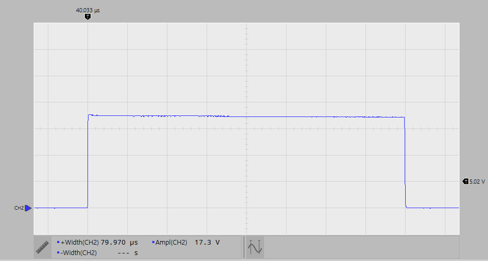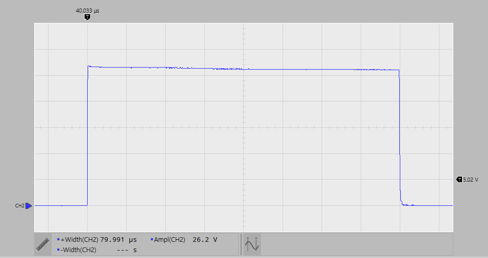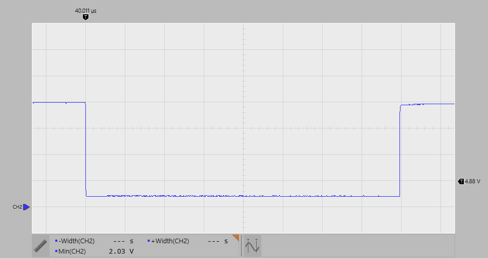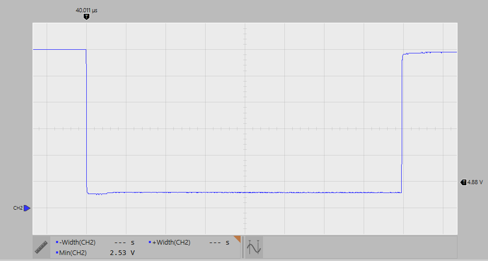TIDUEB8C July 2018 – March 2021 TPS274160
- Description
- Resources
- Features
- Applications
- 5
- 1System Description
- 2System Overview
- 3Hardware, Software, Testing Requirements, and Test Results
- 4Design Files
- 5Software Files
- 6Related Documentation
- 7About the Author
- 8Revision History
3.2.2.1 IO-Link Wake-Up Pulse
As previously described, the PHY must deliver a wake-up pulse of 80 µs and 500 mA. To test this, the enable signal is tied to 3.3 V and the TX signal is supplied from a function generator. This test is repeated with different polarities, loads, and voltages.
 Figure 3-2 Testcase TCM_PHYL_INTF_IQWUH: High-Side Driver, Load = 26 Ω, 20-V Supply, 5 V/div, 10 µs/div
Figure 3-2 Testcase TCM_PHYL_INTF_IQWUH: High-Side Driver, Load = 26 Ω, 20-V Supply, 5 V/div, 10 µs/div Figure 3-3 Testcase TCM_PHYL_INTF_IQWUH: High-Side Driver, Load = 26 Ω, 30-V Supply, 5 V/div, 10 µs/div
Figure 3-3 Testcase TCM_PHYL_INTF_IQWUH: High-Side Driver, Load = 26 Ω, 30-V Supply, 5 V/div, 10 µs/div Figure 3-4 Testcase TCM_PHYL_INTF_IQWUL: Low-Side Driver, Load = 24 Ω, 20-V Supply, 5 V/div, 10 µs/div
Figure 3-4 Testcase TCM_PHYL_INTF_IQWUL: Low-Side Driver, Load = 24 Ω, 20-V Supply, 5 V/div, 10 µs/div Figure 3-5 Testcase TCM_PHYL_INTF_IQWUL: Low-Side Driver, Load = 44 Ω, 30-V Supply, 5 V/div, 10 µs/div
Figure 3-5 Testcase TCM_PHYL_INTF_IQWUL: Low-Side Driver, Load = 44 Ω, 30-V Supply, 5 V/div, 10 µs/divAs Figure 3-2 through Figure 3-5 show, the TIOL111 device passes the tests.